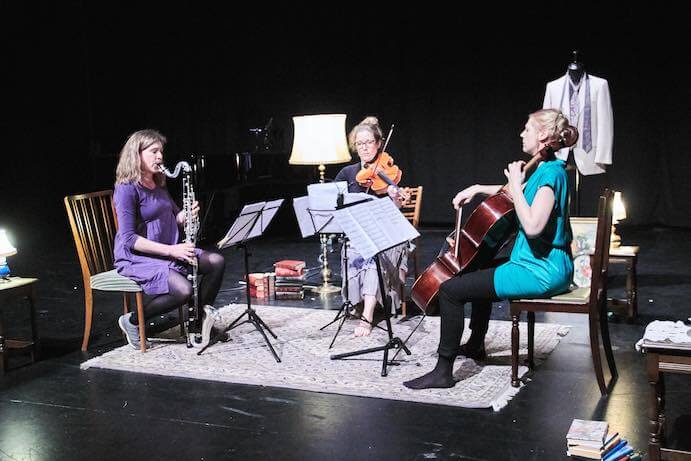In the festival’s 10th anniversary year, SPOR Festival and Artistic Directors Anna Berit Asp Christensen and Anne Marqvardsen sought to transform the entire city of Aarhus, Denmark using a simple concept: EPIPHANY, or a way to “explore the magical and inexplicable aspects of everyday life, and the delve into the extraordinary concealed within the ordinary.” With this theme in mind, Denmark’s flagship experimental performance ensemble SCENATET presented a program of Scandinavian and European premieres that challenged everyday scenarios and transformed them into something exaggerated and unexpected. The performance on May 12, 2017 in the Åbne Scene theater at Godsbanen featured Jagoda Szmytka’s sky-me, type-me (2011), Christian Winther Christensen’s Chorale (2017), and Matthew Rogers’ Weep at the Elastic as it Stretches: An adaptation of N.F. Simpson’s Prayer (2017).
Communication and relationships are central themes in many of Polish composer/artist Jagoda Szmytka’s works, including sky-me, type-me for four performers wielding megaphones. The work explores modern technology-mediated conversations and the instability of these technologies as compared to face-to-face conversation. As the audience entered the hall, the four performers were already positioned face down on individual desks. The soft rustling of the performers’ breath and the gentle tapping of their fingers on the desks signaled the beginning of the concert as each of the performers’ lamps clicked on one-by-one. A hectic yet methodical chorus of familiar sounds converged to form a wild chorus of activity: growling, buzzing, laughing, vocal glisses and hums, intentionally-produced feedback, and screaming. Eventually, coherent words coalesced in a Sprechstimme-like fashion to reveal familiar phone conversation pleasantries (“Hello, how are you? Talk to you soon!”). However, almost as soon as the text became intelligible, words began to overlap and lapse back into cacophonous sound. A collective group moan spiraled downward and ended with a simultaneous clicking off of the lamps to leave the audience in darkness and silence.

Danish composer Christian Winther Christensen’s Chorale, which received its world premiere in early May at the MATA Festival in New York, challenges everyday expectations by exploring textural extended instrumental techniques at extremely soft volumes. Chorale demands that the ensemble—comprised of alto flute, bass clarinet, violin, viola, cello, piano, acoustic guitar, and electric guitar—create soft and subtle grooves in delicate spurts. The work begins with mostly percussive sounds from all of the instruments, and the absence of tone allows the audiences to be highly cognizant of the emergence of pitch. String players slid their fingers and bows vertically along their strings and woodwinds produced key clicks and rushes of air. The electric guitar was only amplified when the acoustic guitar was playing, which created even more timbral possibilities. Quotations of Bach eventually emerge in the guitars while a muted, stopped tone from the prepared piano gently accompanies. By the end of the work, a melodic line with a perceptible contour eventually forms, having completed the journey from texture to tone. SCENATET’s performance of this work was particularly magnificent due to their ability to sustain such a fragile soundscape for ten minutes.
British composer Matthew Rogers’ Weep at the Elastic as it Stretches: An adaptation of N.F. Simpson’s Prayer for bass clarinet, viola, and cello challenged the idea of the conventional performance venue as the stage was transformed into a living room during intermission. Drawing inspiration from N.F. Simpson’s Theatre of the Absurd play A Resounding Tinkle, the eponymous quotation is an excerpt from a prayer delivered as a radio broadcast that revels in the ridiculous. Roger’s work seeks to embody the attitudes of the Theatre of the Absurd through music and presents as a set of quasi-character pieces.

Sustained unison pitches phase in and out of tune, varied articulations form an effervescent texture, and harmony wanders from simple consonance to strident quarter tone tension. An extended cello cadenza on one pitch in multiple positions allows timbre to serve a discernible melodic function. Jaunty, disjunct lines contrast smoothly-contoured legato passages, and the bass clarinet leaps between registral extremes. A simple “boom-chick” accompaniment in the strings lays the foundation for a virtuosic bass clarinet solo, which dissolves into the pitter patter of col legno bowing and tender consonance. However, following this blissful moment, the violist and cellist perform an extended tuning ritual to undo their scordatura tuning, which ludicrously concludes the piece.
SCENATET’s dedication to every aspect of performance is what makes them a superlative new music ensemble. Both the interpretation of the music and the overall visual aesthetic of the performance made for an engaging evening that challenged expectations of the everyday and allowed the audience to extrapolate the extraordinary from the ordinary.
























